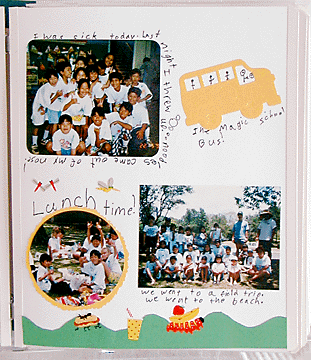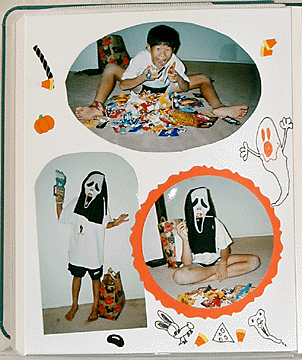


Scrap Happy
Memory book making has become
By Michelle Ramos
all the rage and local craft supply
stores have the doo dads and tools
needed to put it all together
Special to the Star-BulletinYOU spent $500 on an auto-focus camera that guaranteed perfect shots and another $12 on film and film processing. You took the time to gather everyone for the annual group picture around the Christmas tree, drop off the film and wait for its developing.
In exchange, you captured delightful smiles as family and friends tore open Christmas gifts, caught grandma's loving glance toward grandpa as he started his "when I was a little boy we didn't have ... " story, and obtained evidence that dad WAS the culprit who hid the baby's new drum set. Why, then, do these treasures end up hidden in a shoebox or left scattered around the house to deteriorate or be lost forever?
People spend so much money on cameras and other photography equipment but don't take care of the photos that result, said Alissa Lee, a consultant with Creative Memories, a nationwide company that sells scrapbooks and related materials. Lee also teaches classes in scrapbook making.
Scrapbooking or the creation of "memory books" has made a comeback. With its surge of popularity comes an array of acid-free accessories for scrapbook designers to play with. Walk into any craft store or several Longs Drugs stores and you will find a section dedicated to scrapbook accessories. There are stickers, stamps, colored paper, papers with festive designs, decorative scissors, circle cutters, paper cutters, stencils ... almost anything one needs to help add that "special" touch to a page. And many of the accessories are inexpensive.

It is something children and adults can do alone or with a group, Lee said. All it takes are photos; a sharp scissors (children should be supervised); acid-free mounting tape; a waterproof, acid-free pen; and an album or book. "I would also have acid-free, colored paper and a ruler available," Lee said.Lori Bogle, one of Lee's former students, wanted her friends to be part of her wedding scrapbook. Besides being in the pictures, Bogle had each of her friends do at least one page of the album -- none of her friends took a scrapbook class.
"Everyone has different ideas and personalities," Bogle said. "There's no wrong way to make a page." So Bogle invited her friends over and laid out all the supplies. She had seven different types of scissors, a large supply of stickers, templates, rulers, boxes of mounting tape, cut outs, stamps that punched out various designs, different colored pens and all kinds of paper. The night was filled with laughter as past stories emerged and the group reminisced about the photos and the wedding. Bogle's husband got out the camera and snapped pictures of friends laughing, laying out photos, cutting paper and eventually of each person holding up their completed page -- the makings of another scrapbook.
"When I look back, I'll remember who did which page and that will bring back more memories," Bogle said.

Several years ago Kammie Hung, a receptionist at Kaiser-Moanalua Clinic, filled 30 magnetic-type albums with her photos. The albums were popular then but are bad for photos, Hung said. She started scrapbooking about a year and a half ago and teaches scrapbooking classes at Ben Franklin craft store in Mapunapuna. "I removed all my photos from those albums," Hung said. "They are very acidic and tend to deteriorate photos faster."A quality album probably costs around $40, Hung said. But the album is the most expensive part of scrapbooking. For something less expensive, people can bind individual sheets of acid-free paper.
After purchasing a photo-safe album, the rest is easy. "Just remember that the main focus of every page is the photos," Lee said. "I have seen so many albums with beautiful pages and designs but then I have to search for the pictures. The work is supposed to enhance the photos not distract from them."
Simpler pages also keep costs down, Hung said. Both Lee and Hung stressed the key of photo scrapbooks is in the photos and the journaling -- written descriptions that accompany photos.
Many people don't like to write in their albums because they don't like their handwriting or they don't know what to write, Lee said. Handwriting is important though because it is part of a person's history. Lee's scrapbook of her son has some of his first writings. "I love the misspelled words and the way the words are written crooked," Lee said. She also cherishes the shaky writing in one of the cards her grandmother gave her.
Journaling photos can be as simple as writing the names of the people in the picture, where the picture was taken and the date it was taken. Lee advises to write first and last names, especially if the picture is of friends.
Some students also have a problem deciding how to arrange the photos. Hung and Lee both said to select the best photos first. "You don't have to use every picture," Lee said. Then, Lee tries to keep a theme when doing a page. Maybe mom unwrapping her Christmas gifts on one page and dad on another. Or, maybe everyone unwrapping gifts on one page and Christmas dinner on another. Lee suggests four to six photos per page depending on the size of the page and photos. She also tries to choose two or three colors that are in the pictures when selecting paper for framing or making borders on the page.
Framing photos can enhance the photo, Lee said. Cutting photos and having a variety of sizes helps make a page more interesting. Lee suggests ordering prints in duplicate when handing in film to be processed. She also suggests getting the 4x6-size for photos.
Before securing things, photos and other items on the page should be laid out. Then things can be moved around, added or taken away.
Scrapbooking should be fun, Lee said. With the right tools, the photos will outlive you.
Memory books in the making
Alissa Lee gives home classes for individuals or small groups. Her classes cover a variety of areas from basic scrapbook making to making decorative pocket pages. New students taking the basic scrapbook class leave with a scrapbook page that is put together during the class. Incentives are given to hosts of small group workshops and everything except the photos are provided during the class. There is a nominal fee. For more information, call Lee at 487-7442.Kammie Hung will teach a class, 6-8:30 p.m. Jan. 26 at Ben Franklin, Mapunapuna. Participants need to bring 8-12 photos and pay $12. Participants will receive a supply list after paying for the class. For more information, call 833-3800.
There are also several books available on scrapbooks. Cynthia Hart's "Scrapbook Workshop" includes a variety of templates and clip-art. She also gives instructions on making albums. "Joy of Scrapbooking" by Lisa Bearnson and Gayle Humpherys gives tips on "how to take great snapshots," "keeping the focus on the photos" and how to store negatives. The books each cost $19.95.
Acid-free album's best bet
A quality album should contain acid-free, lignin-free, buffered paper. Acid-free because acid deteriorates photos (no photo album is completely acid-free because acid gets transferred from people's fingertips) and lignin-free because lignin -- a naturally occurring substance found in wood -- can break down into acids over time. This is what causes paper to turn yellow.Buffered paper is pH neutral paper that contains calcium carbonate, an alkaline chemical that neutralizes new acids that form within paper over time. It also neutralizes acids that might be exposed to photos from other momentos like a birth announcement or a movie stub from a first date.
To stop acids from transferring from one page to another, and to counteract the formation of more acids, buffered tissue paper can be placed between pages. Certain albums come with chemically stable plastic sleeves which also help protect photos and guard against dirt, acidic fingertips and handling hazards (tearing, spills, etc.).
Photocopying momentos onto acid-free paper is another way of lowering the acid content in a scrapbook. The copy, however, should still be placed in a plastic sleeve or have buffered paper over it since the ink may not be acid-free.
When choosing plastic sleeves, make sure the sleeves do not contain PVC or polyvinyl chloride. This is used in many "pocket page" albums and PVC releases gases that can fade photos in as little as three years.
To test the acidity of items, the Ben Franklin stores in Hawaii Kai and Kailua sell a pH testing pen for $6-$7. The pen contains a chemical ink that turns yellow when applied to highly acidic paper, or blue when the paper is neutral.
Click for online
calendars and events.